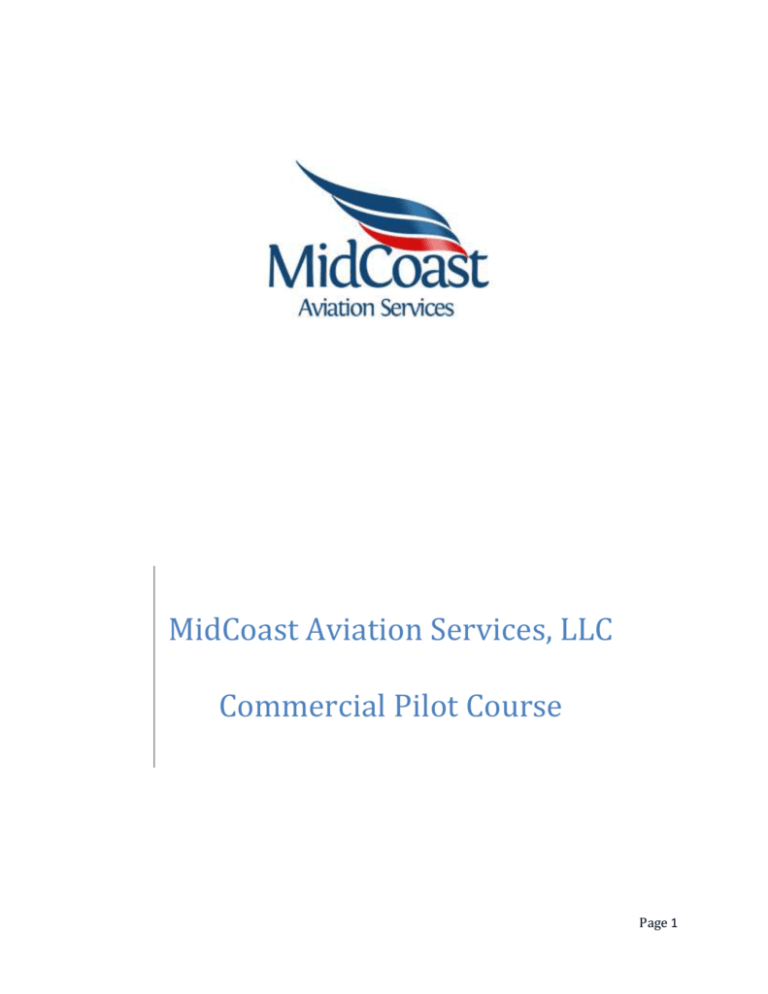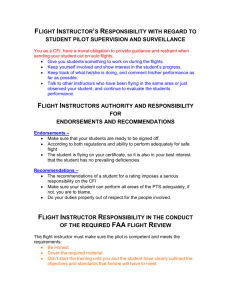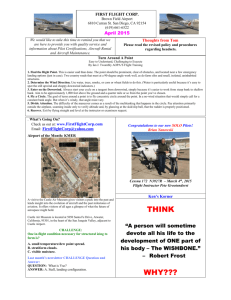Commercial Pilot Training Course Outline
advertisement

MidCoast Aviation Services, LLC Commercial Pilot Course Page 1 Table of Contents General Information a. Course Outline 4 b. Course Prerequisites 4 c. Course Objectives 5 Training Equipment/Area a. Airports 5 b. Aircraft 5 c. Flight Training Aids 6 Facilities a. Ground Training Facilities 6 b. Pilot Briefing Areas 7 Instructors a. Chief and Assistant 7 b. Flight 7 c. Ground 8 Course Policies 8 Appendix A 10 Appendix B 11 Appendix C 12 Appendix D 13 Page 2 RECORD OF REVISIONS REV# COMMENTS DATE INITIALS Page 3 Page 4 TRAINING COURSE OUTLINE MidCoast Aviation Services, LLC is located at the Swinton Smith-Reidsville Municipal Airport and is owned and operated as: MidCoast Aviation Services, LLC 1451 Airport Road Reidsville, GA 30453 COURSE TITLE: Commercial Pilot Course (Airplane) COURSE OUTLINE: This training course meets all the curriculum requirements contained in FAR Part 141 Appendix D. This flight training course will use the ASA Commercial Pilot Syllabus # ASA-PM-C6-PD. All required lesson stages must be successfully completed in order to complete the requirements for the Commercial Pilot Course (Airplane Single Engine Land). CERTIFICATION REQUIREMENTS: The student must demonstrate through knowledge tests, flight tests, and show through appropriate records that he/she meets the knowledge, skill, and experience requirements necessary to obtain a commercial pilot certificate with an airplane category rating and a single-engine land class rating. Graduation from the Commercial Pilot Course dictates the completion of all course requirements with a score of 80% or higher. COURSE PREREQUISITES: The student may be accepted for enrollment in the Commercial Pilot Course with a current medical and a Private Pilot Certificate with an aircraft category and class rating appropriate to the Commercial rating for which the course applies. Also, student must hold an Instrument rating in the appropriate category and class of aircraft, or be concurrently enrolled in an Instrument rating course appropriate to Page 5 the category and class of aircraft and pass the Instrument Practical Test prior to completing the Commercial Pilot Certification Course. COURSE OBJECTIVES: The student will obtain the required knowledge, skill and aeronautical experience to meet the requirements for a Commercial Pilot Certificate under FAR Part 141 Appendix D, as applicable. TRAINING EQUIPMENT AREAS AIRPORTS (FAR 141.38) Reidsville Municipal Airport is the main operations base for all flight training and is continuously available as a public use airport 24 hours a day. The airport has a 5000 foot hard surfaced runway of adequate length for all takeoffs and landings by MidCoast Aviation Aircraft at gross weight under the conditions listed in FAR 141.38 (b) 1-4. The Swinton Smith Reidsville Municipal Airport has a lighted wind direction indicator visible from the ends of all runways, permanent runway lights, taxiway lights, and PAPI lights on both runways, and meets the requirements for day and night VFR and IFR operations. Other airports authorized for use are designated in the Standard Operating Procedures and are not a part of this document. The fuel for MidCoast Aviation Services, LLC aircraft is purchased from the Swinton Smith Reidsville Municipal Airport. In the event it is necessary to purchase fuel during a cross country, fuel may be purchased from an approved airport. Only FAA certified aircraft mechanics perform maintenance for the MidCoast Aviation Services, LLC aircraft. AIRCRAFT (FAR 141.39) Each Aircraft used in the Commercial Pilot Course is: 1. Registered as a civil aircraft. 2. Certified with a standard airworthiness certificate. Page 6 3. Maintained and inspected in accordance with the requirements under subpart E of FAR Part 91 that apply to aircraft for hire. 4. Has dual flight controls and engine-power controls easily reached and operated in a normal manner by both pilots. 5. Airplanes used in any lessons where basic commercial training will occur will be equipped as required by FAR 91.205 for VFR and IFR flight day and night, and certified as required by FAR 91.411 and 91-413. 6. Equipped with one 720 channel, or higher, NAV-COMM radio. 7. Has a checklist and pilot operating handbook as required by FAR 141.75. 8. Will comply with electronic and communications equipment inspections as required per subpart E FAR 91.411. Aircraft used in this course are designated in Appendix B FLIGHT TRAINING DEVICES AND TRAINING AIDS (FAR 141.41) TRAINING AIDS: Each training aid, including any audiovisual aid, projector, tape recorder, mockup, chart, aircraft component, or other special aids used for ground training in the Private Pilot Course will: 1. Be accurate and appropriate for the class in accordance with FAR 141.41(c) as determined by the class instructor approved to teach the class by the Chief or Assistant Chief Instructor 2. Directly relate to and support the material and content of the lesson 3. Be listed as a lesson element in the course syllabus if specific content of a lesson (i.e. DVD) or be listed in the Reference and Training Aids Appendix C at the end of this document, or may be listed in the Commercial Pilot Training Course Outline as General Equipment and Training Aids to be used in the Commercial Pilot Course. The General Training Aids and Instructional Aids are available for use as needed for the lesson by the instructor. The aids may not be stored in the classroom at all times. Page 7 FACILITIES GROUND TRAINING FACILITIES (FAR 141.45) The ground training facilities and pilot briefing areas for the course are located in the building located at 1451 Airport Road Reidsville, GA 30453. The building contains four offices (10’ x12’), a computer-training center (10’ x 12’) and a classroom/conference room (30’x 18’). A drawing of the building layout is attached to this document as Appendix D. The classroom may contain tables and chairs for 30 students maximum. Without the tables a maximum of 50 students may be seated. All classrooms are appropriately lighted, and room temperatures are thermostatically controlled. All of the facility is well ventilated, conforming to local building, sanitation, fire and health codes. The classroom is so designed and located so that students will not be distracted by instruction conducted in other rooms or by flight maintenance operations at the airport. In addition, the offices may be used to conduct one-on-one ground training for the course. PILOT BRIEFING AREAS (141.43) The MidCoast Aviation facility has the classroom and four offices available for instructor-student briefings and ground training. Each office or classroom is dedicated for use by school students exclusively. Each office and classroom has tables and, or desks for flight planning. A telephone and online computer is available at the desk in the lobby of the FBO for contacting Flight Service (FSS), getting weather briefings, and filing flight plans. INSTRUCTORS CHIEF, ASSISTANT CHIEF FLIGHT INSTRUCTORS, AND CHECK INSTRUCTORS (FAR 141.35, 141.36, 141.37) Page 8 The Chief and Assistant Chief Instructors shall meet the respective requirements of FAR 141.35, FAR 141.36, 141.79, and 14 CFR 61.195 (c) and are designated in Appendix (A). The Check Instructors shall meet the requirements of FAR 141.37. FLIGHT INSTRUCTORS Each Flight Instructor used in the course shall meet the requirements of FAR 141.79 as well as possess a current third class or higher FAA Medical Certificate, a Commercial Pilot Certificate – Single Engine Land, and a Commercial Airplane Rating. Instructors must also possess a current Flight Instructor Airplane Certificate – Single Engine Land. OTHER INSTRUCTORS Ground Instructors used in this course must: 1) Hold either a ground instructor certificate with appropriate ratings for the course or 2) Advanced Ground Instructor or 3) Hold a flight instructor certificate with ratings appropriate to the course (Airplane Single Engine) An instructor may be assigned ground training duties provided the Chief Flight Instructor finds the person qualified to give the training, and the training is conducted under the supervision of the Chief/Assistant Chief Flight Instructor who is present at the facility. COURSE POLICIES 1) Instructors are responsible for training the students to acceptable standards in all subject matter areas and objectives of each TASK within the most current FAA Commercial Pilot Practical Test Standards for Airplanes (PTS). If the syllabus lists completion standards for a lesson that are different from the PTS the instructor will use the syllabus completion standards for the grading standard. If completion standards listed for a specific syllabus Page 9 2) 3) 4) 5) 6) 7) lesson are not specified by the lesson, the instructor will use the PTS as the grading standard. Students must have covered the content and met the completion standards pf each lesson for each stage, even if using credited time for the lesson. Under normal circumstances, a student will complete at least one stage and or course every 90 days. At the discretion of the instructor, students who progress rapidly in a specific stage or lesson may, within reasonable variances, continue to the next stage or lesson with less time than is specified in the specific stage or lesson curriculum, provided all content and completions are satisfactorily accomplished. Any reduced lesson hours must be included in other stages or lessons to complete the total ground or flight time specified by category in the training course outline and syllabus in order to satisfactorily complete the course. To satisfactorily complete the Commercial Pilot Course, the student must meet all course objectives and completion standards with a grade of 80% or higher. Stages are accomplished in order. Lessons within a stage may be accomplished out of sequence with Chief Instructor’s approval. Stage checks for each level of completion are required before advancing to the next lesson. Any verified infraction of policy and procedures will result in a failing grade for the lesson. Lessons may not be attempted more than three times (excluding No Go’s) without a review of the student’s progress as required by the Standard Operating Procedures Manual. Page 10 APPENDIX A Chief Flight Instructor Robert W. Smith Page 11 Appendix B 1974 Piper Warrior, PA28A-151, Serial Number 28-7415625; STC’d 160 HP engine, IFR Certified, Garmin GNS 430W GPS, NAV/COM, KX 155 NAV/COM with Glide Slope, Garmin 327 Transponder, KT 86 ADF, Wet Compass, EGT Gauge, 4 place intercom, dual toe brakes, ELT 2010 Sportcruiser, CRUZ, Serial Number P1001078; Light Sport Certified, Dynon Glass D100/D120 (EFIS & EMS), Dynon Autopilot AP74, Dynon HIS HS34, Back-up Airspeed Indicator, Back-up Altimeter, CM 24 Compass, Garmin SL30 NAV/Com, Garmin 330 GTX Mode S Transponder, PM 3300 Intercom Audio Panel, Garmin 696 GPS with XM weather and TIS-B traffic, BRS Parachute 1969 Piper Arrow, P28R-200, Serial Number 28R-35330; IFR Certified, Garmin 340 Audio Panel, Garmin 327 Transponder, Garmin GNS 430W GPS NAV/COM, ADF with independent direction finder head, KX 155 NAV/COM with Glide Slope, Wet Compass, 4 place intercom, 460 ELT 1978 Cessna 172N, C172N, Serial Number 17269939; IFR Certified, Aspen 1000 PFD, Garmin 430W GPS, Garmin SL30 NAV/COM, Garmin 327 Transponder, Garmin 340 Audio Panel, Garmin 496 GPS with XM weather linked to 430W, Standby Attitude Indicator, Enhanced Panel Lighting, 4 place intercom Page 12 Appendix C Reference and Training Aids Dry Erase Boards Dry Erase Markers Training Videos Various Books Various Computers Televisions DVD Player Projector Test Prep Software Page 13 Appendix D (See next Page) Page 14 Page 15






